Mazda 2 Hybrid VS Renault Trafic Bus – Specs, Efficiency & Price Comparison
Which model is the better choice – the Mazda 2 Hybrid or the Renault Trafic Bus? We compare performance (116 HP vs 170 HP), boot capacity (286 L vs ), efficiency (3.80 L vs 6.80 L), and of course, the price (21400 £ vs 36000 £).
Find out now which car fits your needs better!
The Mazda 2 Hybrid (Hatchback) is powered by a Full Hybrid engine and comes with a Automatic transmission. In comparison, the Renault Trafic Bus (Bus) features a Diesel engine and a Manuel or Automatic gearbox.
When it comes to boot capacity, the Mazda 2 Hybrid offers 286 L, while the Renault Trafic Bus provides – depending on what matters most to you. If you’re looking for more power, you’ll need to decide whether the 116 HP of the Mazda 2 Hybrid or the 170 HP of the Renault Trafic Bus suits your needs better.
There are also differences in efficiency: 3.80 L vs 6.80 L. In terms of price, the Mazda 2 Hybrid starts at 21400 £, while the Renault Trafic Bus is available from 36000 £.
Compare all the key specs now and find out which model fits your lifestyle best!
Mazda 2 Hybrid
The Mazda 2 Hybrid impresses with its sleek design and advanced hybrid technology, making it a strong contender in the compact car category. It offers a refined driving experience with smooth transitions between electric and petrol power, ensuring both efficiency and performance. Inside, the cabin is thoughtfully designed, providing comfort and intuitive controls for a modern driving experience.
details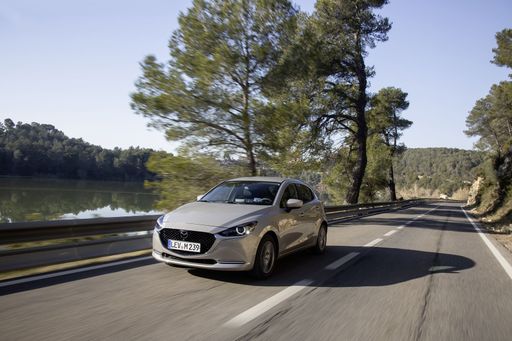 @ de.mazda-press.com
@ de.mazda-press.com
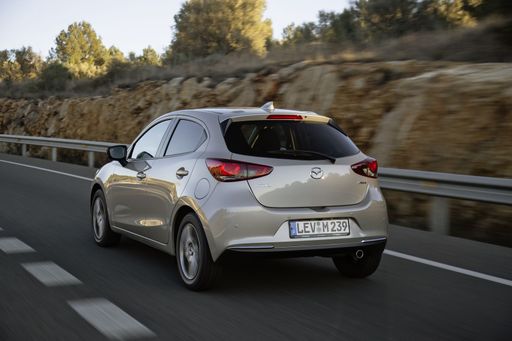 @ de.mazda-press.com
@ de.mazda-press.com
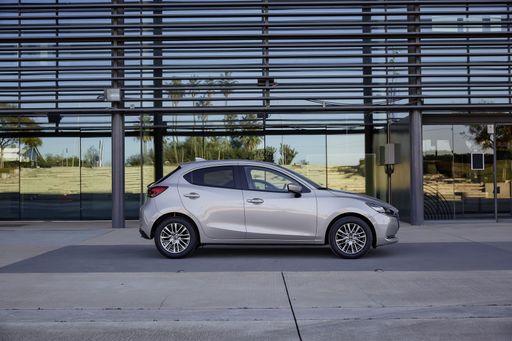 @ de.mazda-press.com
@ de.mazda-press.com
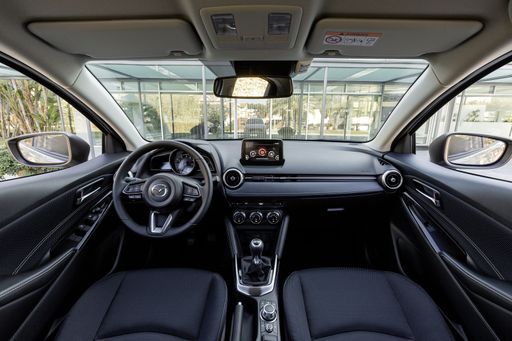 @ de.mazda-press.com
@ de.mazda-press.com
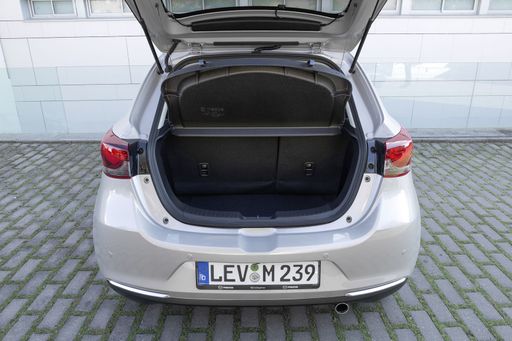 @ de.mazda-press.com
@ de.mazda-press.com
Renault Trafic Bus
The Renault Trafic Bus is a versatile and spacious option for those needing to transport multiple passengers comfortably. With its modern design and practical features, it is well-suited for both business and leisure purposes. Its efficient engine and smooth handling make it a reliable choice for long journeys.
details

|
|
|
|
|
Costs and Consumption |
|
|---|---|
|
Price
21400 - 28200 £
|
Price
36000 - 51900 £
|
|
Consumption L/100km
3.8 - 4 L
|
Consumption L/100km
6.8 - 7.2 L
|
|
Consumption kWh/100km
-
|
Consumption kWh/100km
-
|
|
Electric Range
-
|
Electric Range
-
|
|
Battery Capacity
-
|
Battery Capacity
-
|
|
co2
87 - 93 g/km
|
co2
178 - 190 g/km
|
|
Fuel tank capacity
36 L
|
Fuel tank capacity
80 L
|
Dimensions and Body |
|
|---|---|
|
Body Type
Hatchback
|
Body Type
Bus
|
|
Seats
5
|
Seats
8 - 9
|
|
Doors
5
|
Doors
4
|
|
Curb weight
1180 kg
|
Curb weight
2031 - 2340 kg
|
|
Trunk capacity
286 L
|
Trunk capacity
-
|
|
Length
3940 mm
|
Length
5080 - 5480 mm
|
|
Width
1745 mm
|
Width
1956 mm
|
|
Height
1505 mm
|
Height
1973 - 1974 mm
|
|
Payload
435 kg
|
Payload
730 - 1010 kg
|
Engine and Performance |
|
|---|---|
|
Engine Type
Full Hybrid
|
Engine Type
Diesel
|
|
Transmission
Automatic
|
Transmission
Manuel, Automatic
|
|
Transmission Detail
-
|
Transmission Detail
Manual Gearbox, Dual-Clutch Automatic, Schaltgetriebe
|
|
Drive Type
Front-Wheel Drive
|
Drive Type
Front-Wheel Drive
|
|
Power HP
116 HP
|
Power HP
110 - 170 HP
|
|
Acceleration 0-100km/h
9.70 s
|
Acceleration 0-100km/h
10.6 - 16.5 s
|
|
Max Speed
175 km/h
|
Max Speed
161 - 186 km/h
|
|
Torque
-
|
Torque
300 - 380 Nm
|
|
Number of Cylinders
3
|
Number of Cylinders
4
|
|
Power kW
85 kW
|
Power kW
81 - 125 kW
|
|
Engine capacity
1490 cm3
|
Engine capacity
1997 cm3
|
General |
|
|---|---|
|
Model Year
2024
|
Model Year
2023 - 2024
|
|
CO2 Efficiency Class
B
|
CO2 Efficiency Class
G
|
|
Brand
Mazda
|
Brand
Renault
|
Mazda 2 Hybrid
The All-New Mazda 2 Hybrid: A Leap into the Future of Urban Driving
The 2024 Mazda 2 Hybrid is a testament to Mazda’s commitment to blending innovation and efficiency in a compact package, perfect for urban driving. This hybrid marvel harmoniously balances performance, style, and cutting-edge technology.
Engineered Excellence: Power and Performance
Under the bonnet, the Mazda 2 Hybrid is powered by a full-hybrid system. This sophisticated mechanism combines a combustion engine with electric power, generating a robust 116 PS (or 85 kW). With a responsive acceleration of 0-100 km/h in just 9.7 seconds, this car ensures a dynamic driving experience without compromising fuel efficiency.
Efficiency and Environmental Responsibility
The Mazda 2 Hybrid shines in fuel economy with a noteworthy consumption range of 3.8 to 4 L/100 km. Not only does it offer outstanding efficiency for budget-conscious drivers, but it also projects a responsible attitude towards the environment. With CO2 emissions ranging from 87 to 93 g/km, it holds a respectable B efficiency rating, making it an attractive option for eco-friendly car enthusiasts.
Design and Dimensions: The Compact Urban Companion
With its hatchback design, the Mazda 2 Hybrid embraces both style and practicality. Its compact dimensions—3940 mm in length, 1745 mm in width, and 1505 mm in height—make it ideal for navigating through tight city streets. Despite its size, the Mazda 2 Hybrid offers a comfortable and spacious interior for up to five passengers, complemented by a generous boot capacity of 286 litres.
Technology and Comfort: Innovative Features
The Mazda 2 Hybrid is equipped with a CVT (Continuously Variable Transmission) that offers a seamless driving experience. Advanced features like state-of-the-art infotainment systems and connectivity options ensure both driver and passengers enjoy a connected journey. The model is available in several trim levels, including Centre-Line CVT, Exclusive-Line CVT, Homura CVT, Homura Plus CVT, and Prime-Line CVT, each offering unique features to tailor to various preferences.
Safety and Assurance
In addition to comfort and performance, the Mazda 2 Hybrid prioritises safety. Its robust structure and advanced safety systems deliver peace of mind while traversing urban landscapes. Mazda’s focus on safety innovation ensures each journey is as secure as it is enjoyable.
A Smart Investment: Pricing and Running Costs
With a starting price ranging from €24,990 to €32,890, the Mazda 2 Hybrid positions itself as an attractive choice for those seeking cutting-edge hybrid technology without breaking the bank. Its running costs, including a monthly expenditure between €723 and €855 and a cost per kilometre ranging from 28.9 to 34.2 cents, underscore its economic benefit over time.
Conclusion: The New Benchmark for Urban Hybrids
The Mazda 2 Hybrid represents a harmonious amalgamation of efficiency, innovation, and practicality, tailored for the modern urbanite. As cities continue to evolve, the need for sustainable and versatile transport solutions becomes paramount, and the Mazda 2 Hybrid meets these needs with aplomb, setting a new benchmark for hybrids in its class.
Renault Trafic Bus
A Glimpse into the Renault Trafic Bus: An Icon of Versatility and Innovation
Amongst the plethora of vans designed for both business and leisure, the Renault Trafic Bus stands out as an exemplar of functionality, innovation, and style. Let's delve into what makes the Renault Trafic Bus a popular choice in the UK and across Europe, particularly focusing on its technical specifications and state-of-the-art features.
Performance Dynamics: Power Under the Hood
The Renault Trafic Bus, a staple in Renault's fleet, is driven by a robust diesel engine configuration with power outputs ranging from 110 PS to a formidable 170 PS. The diesel engines combine efficiency and power, offering torque figures between 300 to 380 Nm, ensuring smooth power delivery and capable load hauling.
Drivers can choose between manual and automatic transmissions, both designed to complement the Trafic's front-wheel-drive system. This flexibility ensures that drivers experience enhanced driving comfort whether they are navigating urban roads or cruising on the motorway.
Efficiency Meets Economy
The Trafic Bus showcases impressive fuel economy with consumption figures ranging from 6.8 to 7.2 litres per 100 kilometres. This efficiency is crucial for businesses aiming to minimise operational costs and for families seeking budget-friendly travel options.
With a generous fuel tank capacity of 80 litres, the Renault Trafic Bus is built to cover long distances with fewer fuel stops, making it an ideal choice for long haul journeys.
Technological Innovations and Comfort
The Trafic Bus isn't just about robust performance. Renault has integrated a suite of technological innovations designed to enhance driver and passenger comfort. Its cabins are equipped with the latest infotainment systems and safety technologies, providing an optimal blend of comfort and convenience.
The various trims, such as Life, Start, Spaceclass, and their respective EDC variants, cater to different needs and preferences, ensuring that customers can find the perfect configuration for their requirements.
Design and Dimensions: Space for Every Purpose
Space and versatility are at the heart of the Trafic Bus design. With its dimensions ranging from a length of 5080 to 5480 mm, and a width of 1956 mm, this vehicle offers ample room for passengers and cargo alike. The height stands between 1973 and 1974 mm, ensuring that even taller individuals can travel comfortably.
With seating for up to eight people and a payload capacity between 730 to 1010 kg, the Trafic Bus can transform seamlessly between a people-mover and a goods carrier.
Environmental Considerations
Renault has engineered the Trafic Bus with environmental responsibility in mind. The CO2 emissions range from 178 to 190 g/km, which, while modest for its class, aligns with the efficiency and performance goals set for this versatile vehicle. The CO2 efficiency class is rated as 'G', offering transparency in its environmental impact profile.
Conclusion: A Leader in Its Class
The Renault Trafic Bus continues to lead its segment through a blend of power, efficiency, and technological advancements. Whether it's for commercial transport or family adventures, the Trafic offers a reliable and adaptable solution, setting a high standard for multi-purpose vehicles.
For those seeking a distinguished blend of utility and comfort, the Renault Trafic Bus emerges as an exceptional choice, promising performance and innovation on every journey.
The prices and data displayed are estimates based on German list prices and may vary by country. This information is not legally binding.
